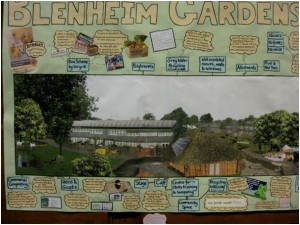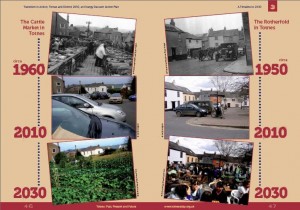24 Sep 2010
Transition as a Pattern Language: Visioning
 Visioning is a core activity that will run through all the activities of your Transition initiative. It will be most obviously a key aspect of creating ENERGY DESCENT ACTION PLANS, itself an exercise in collective visioning, but will also underpin your initiative’s STRATEGIC THINKING.
Visioning is a core activity that will run through all the activities of your Transition initiative. It will be most obviously a key aspect of creating ENERGY DESCENT ACTION PLANS, itself an exercise in collective visioning, but will also underpin your initiative’s STRATEGIC THINKING.
The challenge:
The future can be a scary place. For many people, not being able to imagine a lower carbon world is a huge impediment to designing and realising it. Popular culture is filled with dark tales of apocalypse, and at the same time our local authorities plan, on our behalf, for a future that can never possibly come to pass. If our communities suffer from a similar collective failure of the imagination, Transition will be impossible.
Core Text:
Visioning is one of the things that distinguishes the Transition approach from most other environmental approaches. Rather than campaigning against a grim and disastrous portrayal of the future, Transition suggests that instead we start with creating a positive vision of a future that we do want. It asks, “if you woke up in, say, 2030, and the Transition had been successfully managed, what would it look like, feel like, smell like, sound like? What would you have for breakfast? What would you see when walking down the street?” When I interviewed a senior planner for Totnes, I asked him that question, and his response was revealing. “I suppose it would probably feel like going back to the way it was”, he told me, before going on to paint a picture of the settlements of his childhood. Might it be that one of the reasons the Copenhagen climate negotiations failed was few of those there on our behalf went with such a vision in their minds? Why fight for a low carbon future if you can’t even imagine it?
The first thing to consider when it comes to visioning is that the context is very important. A completely open-ended visioning process will produce little of value: in the Transition context what matters is that our visioning takes place in the context of a world which has responded to climate change, a world with far less net energy available than today, a world which has moved beyond economic growth, and world which adapted in time in a creative and purposeful way. The Totnes Energy Descent Action Plan1 (EDAP) , the first such plan in the UK, begins by stating its assumptions, before setting out its vision of the Totnes of 2030.
One of the simplest tools for visioning is to invite people to close their eyes and to invite them to imagine themselves walking down the street in 2030, stopping to look around, and asking them questions like “what can you see?” and “what does it sound like?” You can then invite people to record their impressions through drawing, painting, writing poetry or writing stories. There is a case for arguing that popular narratives today, that we encounter in the media, tend to be based on drama and conflict, and so for some people visions might best be obtained by asking people to write the tabloid headlines of 2030, or sometimes by giving them headlines from the papers of today and asking them to write a 2030 story with that headline.
 Transition Taunton Deane ran an exemplary visioning exercise with their local Council between July and September 2009, at the request of the Council’s Chief Executive Officer. It brought together every one of the Council’s 375 employees, from senior management to cleaners, to create a vision for a post-oil Taunton Deane. The resultant report, “Towards a Resilient Taunton Deane”2 , set out a dynamic vision for the area. For example, for energy, the vision was:
Transition Taunton Deane ran an exemplary visioning exercise with their local Council between July and September 2009, at the request of the Council’s Chief Executive Officer. It brought together every one of the Council’s 375 employees, from senior management to cleaners, to create a vision for a post-oil Taunton Deane. The resultant report, “Towards a Resilient Taunton Deane”2 , set out a dynamic vision for the area. For example, for energy, the vision was:
“as the ongoing international energy crisis made the national grid (gas and electricity) more unreliable, the Borough set out to become more energy resilient. By 2026 its communities, businesses and local Council are producing over 50% of their own energy needs”
…and for food:
“rather than relying on high levels of food imports to the UK (as in 2009) Taunton Deane and its surrounding neighbours have become over 80% self sufficient in food.”
In April 2009, Transition Town Kingston (TTK) did a community visioning process together with Artgym™, a community arts group. The project, “Our Kingston, Our Future”, brought together people under 25 with people over 50 to look at the past, present and future of Kingston. It aimed to build understanding by bringing different generations together with film-makers, artists and designers. The resultant drawings and other artworks were exhibited at Kingston Museum, alongside an exhibit about TTK. Visions generated through these and other visioning approaches form a crucial foundation for the ongoing work of your Transition initiative.
The solution:
Try and weave into everything your Transition initiative does elements of visioning. Ensure that the group’s ‘vision of the future’ can grow and change, and that your initiative attempts, in all of its work, to embody the question, “if you were to wake up in 20 years, in this world which had successfully made the Transition, what would it look like, feel like, smell like, sound like?”.
Connections to smaller patterns:
Of course visioning without BACKCASTING is mere fantasy, just a romantic wish list. ARTS AND CREATIVITY have a huge role to play in visioning, in the widest sense, helping to bring a low carbon, more localised world to life. Sometimes, a background in permaculture design can help people in THINKING LIKE A DESIGNER. Lots of useful visioning also takes place through COMMUNITY BRAINSTORMING TOOLS like Open Space. There is also a lot to be said in starting visioning work in ORAL HISTORIES, giving a historical context.
References:
1. Hodgson, J, Hopkins, R. (2010) Transition in Action: Totnes and District 2030: an Energy Descent Plan. Transition Town Totnes/Green Books.
2. Godfrey, C., Birch, P. (2009) Towards a Resilient Taunton Deane; 375 Voices, One Story. Taunton Deane Borough Council & Transition Town Taunton.
* * *
Please leave your comments, thoughts, anecotes, suggestions for photos, project and anything else that could make this pattern richer and more representative than it is now here.
